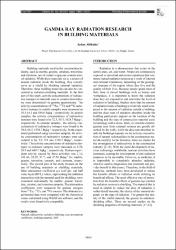| dc.description.abstract | Building materials used in the construction industry, such as marble, granite, ceramics, travertine, and cimstone, are of crustal origin and contain natural radiation. While these materials act as a source of natural radiation inside the building, they actually serve as a shield by blocking external radiation. Therefore, these building materials can also be considered as radiation-shielding materials. In the first part of this study, activity concentrations of radioactive isotopes in materials used in construction industry were determined via gamma spectrometry. The activity concentrations of Ra-226, Th-232 and K-40 radio-active isotopes in marble samples were measured as 10.5, 14.3 and 584.6 Bqkg(-1), respectively. In granite samples, the activity concentrations of radioactive isotopes were found to be 72.3, 63.5, 1024.7 Bqkg(-1), respectively. In ceramic samples, the activity concentrations of radioactive isotopes were found to be 39.8, 68.5, 1338.7 Bqkg(-1), respectively. In the experiment performed using travertine samples, the activity concentrations of radioactive isotopes were calculated to be 5.9, 9.9 and 1338.7 Bqkg(-1), respectively. The activity concentrations of radioactive isotopes in cimstone samples were measured as 6.78, 26.9 and 649.7 Bqkg(-1), respectively. Radium equivalent activity caused by these activities was 21.6, 101.46, 32.29, 91.7, and 47.51 Bqkg(-1) for marble, granite, travertine, ceramic, and cimstone, respectively. The second part of the study focused on the use of building materials as shielding materials. Mass attenuation coefficient mu/rho (cm(2)/gr), and half value layer (HVL) values, representing the radiation interaction with the material used for shielding, were examined individually for nimble, granite, travertine, ceramic, and cimstone samples. The attenuation coefficients were measured for gamma energies from Eu-152, Cs-137, and Co-60 sources. The obtained experimental data were compared with the theoretical values calculated using WinXCom software, and the results were found to be compatible. | en_US |


















